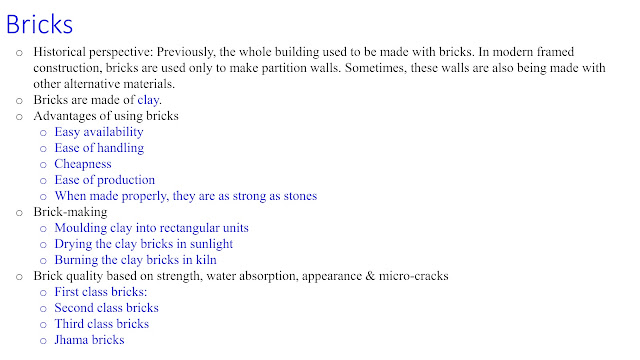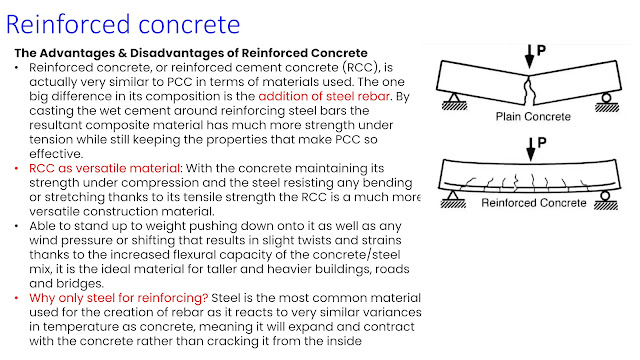Introduction to Civil Engineering
Unit-I
Mandate of Civil Engineers
Civil engineers deal with analysis, design, construction,
maintenance and de-commissioning of the following civil facilities
·
Buildings: They
provide safe shelter to people starting from low-cost housing to luxury
apartments.
·
Roads: They
provide smooth transportation of goods and people by constructing village roads,
state highways, national highways,express highways, along with necessary
bridges, fly-over, subways,etc
·
Irrigation structures:
They provide controlled water supply for agriculture through construction of
dams, canals, reservoirs along with flow control provisions like weirs,
barrages, sluice gates, etc
·
Water supply:
They provide potable water for domestic uses like drinking, bathing, washing,
etc by constructing water storage structures (reservoirs, overhead tanks, etc),
and water supply systems (pipe network, plumbing, etc)
·
Sewage disposal:
They provide healthy disposal and treatment of used water by constructing
sewage drains, sewage treatment plants, septic tanks, etc
·
Industrial structures:
Huge power plants (thermal power plants, hydroelectric plants, nuclear power
plants, etc), factories and manufacturing industries require special structures
to house the equipments for proper functionsing.
·
Other means of
transport: in addition to road transport, civil engineers provide
railway tracks for goods, passenger and high-speed railway traffic. They
construct harbours, inland water ways and airports.
·
Bridges: Gaps in
smooth transportation are caused by obstructions like rivers, other road/
railway crossings and valleys. These gaps are bridged by constructing various
kinds of bridges (cable-stayed bridges, cable suspension bridges, arch bridges,
truss bridges, cantilever bridges, prestressed concrete bridges, etc) for
roads, railway lines and for passing water canals
·
Tunnels: Passage
through mountains is made shorter and faster by constructing tunnels through
hills.
Civil Engineering specializations
In order to provide industry-standard services
in the wide variety of civil engineering domains, specializations are required
for focussed training and excellence of quality. Accordingly, the following
broad specializations are identified
·
Surveying:
o
Definition: It
is the science and art of determining the relative postions of points on the
earth’s surface by measuring distances, direction and vertical heights directly
or indirectly.
o
Application: Surveying
helps in preparing maps and plans, which help in project implementation. For
example, when setting out the alignments for roads, railway lines, canals, etc,
when deciding the location of a dam or airport or harbour, marking the
locations of various rooms of a house, etc surveying is done.
o
Quantity surveying:
Surveying also involves estimating the cost of the facility being constructed
before starting.
o
Modern surveying:
In modern days, a lot of surveying happens by remote sensing of data by
satellites, drones, etc
· Geotechnical Engineering:
o
Role: Any civil
engineering structure will ultimately rest on the ground which is either soil
or rock. The safe transfer of various forces from the civil engineering
structure to the ground is ensured by geotechnical engineers.
o
Application:
Knowledge of Geotechnical engineering is required for foundation design,
earthen dams, embankments, roads and railway tracks, retaining walls,etc
o
Method: They
assess the engineering properties of soils to ensure safe and serviceable
performance of the structure under both short and long term loads.
o
Prior Knowledge:
The knowledge of geology is very much important for Geotechnical engineers
·
Structural Engineering:
o
Def: Structure
is any element that resists loads by deformation
o
Examples: There
are many structures like buildings, bridges, dams, fly-overs, water tanks, etc
o
Each structure can have many components like
slabs, beams, columns, foundations, etc
o
Objectives: The
components, their connections, the overall structures are to be designed in
such a way that they remain safe and can be used for the desired purpose for
which they are meant.
o
Prior Knowledge: The
knowledge of mechanical properties of materials, loading, methods of analysis
and design regulations is required to be a structural engineer.
·
Transportation Engineering
o
Applications: It
includes the facilities for various means of transportation, like roads,
railway lines, airports, harbours, inland waterway, etc
o
Roads and railway
tracks: The roads & railway tracks should be of sufficient strength
to bear the loads of heavy vehicles, proper alignment to ensure safe
visibility, proper elevation to ensure safety at all speeds, proper drainage
and many other requirements for safe operation of vehicular traffic.
o
Airports:
Airports require strong runways that work in all environmental conditions,
taxiways, terminal buildings, control towers, etc
o
Ports and Harbours:
These facilities are needed to dock ships of various sizes so that they can be
loaded/ unloaded with cargo, and also for their regular maintenance and repair
works.
·
Irrigation
and Water reources engineering
o
Definition:
Irrigation is the process of supplying water by artificial means to
agricultural fields for raising crops. Where rainfall or ground water is
insufficient, water flowing in a river can be stored by constructing dams, and
diverting the water into the canals and conveyed to agricultural fields
o
Mandate: In
addition to, the dams and canals, structures which measure & control the
flow, likes weirs, barrages, etc and bridges for canals (aqueducts), are
designed by water resource engineers. Facilities required for power generation
through hydro-electric projects are also part of water reource engineers
·
Water supply and wastewater engineering (Environmental Engineering) :
o Importance: people in
cities, towns and villages need potable water for various domenstic purposes.
Many industries like textile industry, leather industry, etc need reliable
supply of water. The water available may not be fit for direct consumption. In
such cases, water should be treated (purified) and supplied to public
o Role:
§ Water sources are to be identified
and developed.
§ For water purification,
sedimentation tanks, filters beds, etc should be designed and maintained.
Suitable pipelines are to be designed to supply water to individual consumer
§ The waste water (Used water) is to
be collected and disposed off safely without causing damage to sustainability
of ecology.
o
Environmental engineering also involves assessment of impacts caused by human activities on
environment and ecology, assessment of pollution levels, disposal of solid
waste, e-waste, industrial wastes, etc
·
Building materials and
construction Technology
o Importance: A wide range
of materials and equipments are used in building construction. It becomes
important for any construction engineer to be well versed with their properties
and their application in varying circumstances. In addition, the efficient use
of man-power and other resources at the construction site is of utmost
importance for economical and safe implementation of any construction project.
o
Role: Planning
& managing the sequence of activities along with the required resources, so
that the project is completed efficiently and economically within the given
timelines.
General
o
Any
engineering structure makes use of wide variety of materials
o
These
materials can be referred to as engineering materials or building materials or
construction materials
o
One
should know their properties to have a safe, economical and serviceable product
(structure)
o
The
building materials usually are selected based on their
o
Easy
availability in required amounts
o
Strength,
stiffness, toughness, hardness, etc
o
Weight
and cost
o
Properties
in adverse environments like rain, direct sunlight, wind, earthquake, snow
fall, etc
o
Examples
§ Stones
§ Bricks
§ Timber
§ Steel
§ Cement
·
Cement
mortar
·
Cement
concrete
§ Alternate building materials
§ Composites
§ Smart materials



















No comments:
Post a Comment